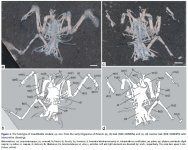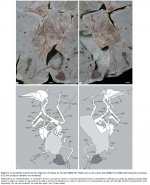Fred Ruhe
Well-known member

Gerald Mayr, Zbigniew M. Bocheński, Teresa Tomek, Krzysztof Wertz, Małgorzata Bieńkowska-Wasiluk & Albrecht Manegold, 2019
Skeletons from the early Oligocene of Poland fill a significant temporal gap in the fossil record of upupiform birds (hoopoes and allies)
Historical Biology, An International Journal of Paleobiology Latest Articles
Abstract: https://www.tandfonline.com/doi/abs/10.1080/08912963.2019.1570507?journalCode=ghbi20
Upupiformes is the avian clade including extant hoopoes (Upupidae) and wood hoopoes (Phoeniculidae). Upupiform birds are abundantly represented in some Eocene fossil sites and are also known from early Miocene localities, but the fossil record in between is surprisingly scant. This gap of over 25 million years is bridged by two skeletons from the early Oligocene of Poland. One of the fossils is described as a new species, ?Laurillardia smoleni, sp. nov., the other is tentatively referred to Laurillardia munieri Flot, 1891. We detail that these stem group Upupiformes are more closely related to the crown group than are the Eocene Messelirrisoridae. The specimens show that very small upupiform birds coexisted with passerines (Passeriformes) for at least ten million years and challenge previous hypotheses that the arrival of passerines in Europe led to the demise of small non-passeriform arboreal birds. It remains elusive, why small upupiform birds became extinct in the Northern Hemisphere. Even though these insectivorous birds may not have found enough food after the emergence of cold Northern Hemispheric winters, it is an open question why very small-sized upupiform birds do not occur in the tropical regions of Asia but are today restricted to Africa south of the Sahara.
http://www.zoobank.org/urn:lsid:zoobank.org:pub:A90B22E7-C3EC-4EAE-A757-F073EAF521F3
KEYWORDS: Aves, evolution, fossil birds, Laurillardia, morphology, taxonomy
Enjoy,
Fred
Skeletons from the early Oligocene of Poland fill a significant temporal gap in the fossil record of upupiform birds (hoopoes and allies)
Historical Biology, An International Journal of Paleobiology Latest Articles
Abstract: https://www.tandfonline.com/doi/abs/10.1080/08912963.2019.1570507?journalCode=ghbi20
Upupiformes is the avian clade including extant hoopoes (Upupidae) and wood hoopoes (Phoeniculidae). Upupiform birds are abundantly represented in some Eocene fossil sites and are also known from early Miocene localities, but the fossil record in between is surprisingly scant. This gap of over 25 million years is bridged by two skeletons from the early Oligocene of Poland. One of the fossils is described as a new species, ?Laurillardia smoleni, sp. nov., the other is tentatively referred to Laurillardia munieri Flot, 1891. We detail that these stem group Upupiformes are more closely related to the crown group than are the Eocene Messelirrisoridae. The specimens show that very small upupiform birds coexisted with passerines (Passeriformes) for at least ten million years and challenge previous hypotheses that the arrival of passerines in Europe led to the demise of small non-passeriform arboreal birds. It remains elusive, why small upupiform birds became extinct in the Northern Hemisphere. Even though these insectivorous birds may not have found enough food after the emergence of cold Northern Hemispheric winters, it is an open question why very small-sized upupiform birds do not occur in the tropical regions of Asia but are today restricted to Africa south of the Sahara.
http://www.zoobank.org/urn:lsid:zoobank.org:pub:A90B22E7-C3EC-4EAE-A757-F073EAF521F3
KEYWORDS: Aves, evolution, fossil birds, Laurillardia, morphology, taxonomy
Enjoy,
Fred





